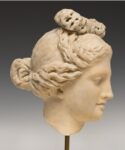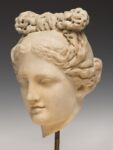


Unknown
Roman
Head of Aphrodite, 2nd c. CE, after a Hellenistic Type
marble
11 1/2 in.
SBMA, Gift of Wright S. Ludington
1978.4.9
RESEARCH PAPER
The head of the Greek goddess Aphrodite is a beautiful Roman replica of a Greek original and dates back to the 2nd century CE.
Aphrodite’s elaborate hairdo consists of a topknot and artfully arranged hair in braids and waves around her beautiful face. There are quite a few drill holes in her hair which showcase even more Aphrodite’s carefully arranged hairstyle. The drill holes were created by the sculptor with differently shaped drill bits and chisels. The head is made out of marble, most likely a fine- grained marble from Carrara (at the time called Luna) from the northwest coast of Italy. (Ramey)
The sculptor of the Head of Aphrodite is unknown; however, the most prominent and prolific sculptor was Praxiteles or Athens (395-330 BCE), and it is possible that this sculpture was made by either Praxiteles or more likely by one of his many students.
“Aphrodite is the Olympian goddess of love, beauty and pleasure and the equivalent of the Roman goddess Venus.” (Kidskonnect) According to one Greek legend Aphrodite’s parents were Zeus and Dione, thus making Aphrodite a second generation goddess. According to another legend Aphrodite arose from the foam in the waters of Paphos on the island of Cyprus. The foam was created by Cronus, who cut of his father’s - Uranus – genitals and threw them into the sea.
‘Aphros’ in Aphrodite means seafoam in Greek.
Zeus married Aphrodite to Hephaestos, a rather ugly god of fire, so that Aphrodite’s beauty would not cause a war between the gods, who all wanted her affection. But Aphrodite did not remain faithful and engaged in lots of affairs with both gods and humans, resulting altogether in about 13 children.
Aphrodite also won a beauty contest with herself, Hera (wife and sister of Zeus) and Athena (daughter of Zeus). All three bribed the judge, Paris; Aphrodite promised him the most beautiful girl in the Universe--Helena (also a daughter of Zeus). Aphrodite won the contest and Paris eloped with Helena, thus starting the Trojan War.
Today Aphrodite is considered a symbol of beauty and love, a creator of love between humans.
If we look at the marble Head of Aphrodite with those symbols of beauty and love in mind, her sculpted stone head appears to be loving and warm and soft, somewhat lifelike.
Prepared for the Santa Barbara Museum of Art Docent Council by Sabine Nocker, 2020.
BIBLIOGRAPHY
Del Chiaro, Mario A. “Classical Art: Sculpture.” Santa Barbara: Santa Barbara Museum of Art, 1985, pp. 48-49.
Kidskonnect.com. “Aphrodite (Goddess) Facts & Worksheet.”
https://kidskonnect.com/people/aphrodite-goddess/
Ramey, Mike. “Techniques Paper: Roman Marble.” Unpublished paper, Santa Barbara Museum of Art, October 2013.
Softschools.com. “Aphrodite Facts.” https://www.softschools.com/facts/ancient_civilizations/aphrodite_facts/2539/
COMMENTS
This head is clearly a Roman work based on Hellenistic types, derived in turn from Praxitelean prototypes, which are characterized by the "smokey" or soft finish given to the features. This slightly under life-size head of Aphrodite may originally have been part of a statue not unlike the SBMA Aphrodite (1973.52). In this head the deep drill holes are used to suggest hair texture and date the statue in the 2nd century CE.. Though a copy, it is a sensitive and beautiful version of a Greek original.
The piece has an oblique break at the neck. The topknot was once broken away but has been
reattached. There has been considerable drillwork thoughout the hair. There are signs of much reworking of the surface-polishing and recutting, particularly in the central area of the hair, eyes, nose and the corners of the mouth.
- Mario A. DelChiaro, Classical Art Sculpture, SBMA Catalog, 1984, pp. 48-49
SBMA CURATORIAL LABELS
This head of the goddess Venus comes from a Roman copy of an earlier Greek sculpture. The
style resembles the work of the fourth century BCE artist Praxiteles, who famously created the
first nude sculpture of the goddess and whose work was copied for centuries. Recent research
has also shown that this head, after being broken from its body some time in antiquity, was
attached to another ancient body of the goddess probably some time in the eighteenth century.
It was common in recent centuries to connect different fragments to create a ‘complete’ ancient
sculpture. Eventually the head and the body were separated again and today the body can be
found at the Tampa Museum of Art.
The goddess wears a headband, with her hair in a broad knot on top of her head and collected
in a bun at the back. This hair style reflects the sculpture’s influence from an earlier sculpture. In
the second century CE, elaborate hairstyles inspired by sculptures of goddesses came into
fashion for wealthy Roman women who took their cue from empresses in wanting to be
represented as Venus in their portraiture. To achieve these complicated styles with real hair,
they would have relied on hair extensions carefully braided in and arranged by the enslaved
members of their household.
- Thayer Reopening, 2021
